Tonga & Fiji Fauna
REPTILES
Fiji is home to several species of snakes (both terrestrial
and marine), geckos, iguanas, and sea turtles.
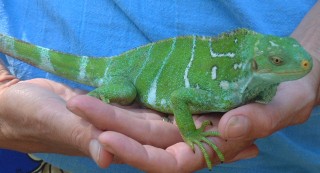 |
The Crested Iguana
Brachylophus vitiensis (also called the common iguana) is believed to have arrived
on floating vegetation from South America long ago, as there are no crested
iguanas in Southeast Asia. Only identified in the later 1970’s, this may be a
subspecies endemic to Fiji. They reside on Yadua (Yanduna) Island off western Vanua
Levu and the Yasawa Islands in northwestern Fiji. They can reach up to a meter
in length. The photographed individual lives at Kula Eco Park in Viti Levu, and
is allowed to be held as part of the school education programs. |
| The Banded Iguana Brachylophus fasciata is more widely distributed, occurring
not only in Fiji, but Wallis, Futuna and Tonga. The male (below) displays wide band along
its body, but the female (on the right) is a solid brilliant green. Kula Eco Center in Viti Levu has had a very successful breeding program which may be halted as the
government decids what to do with all the iguanas. They do not exist in
the wild on Viti Levu due to the predatory actions of the (introduced) mongooses. |
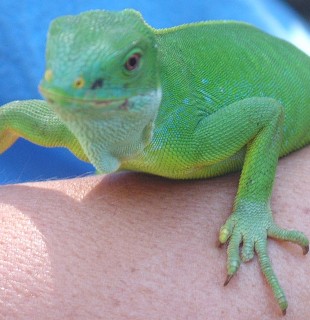 |
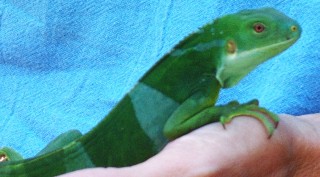 |
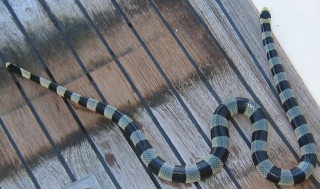
The Banded Sea Krait's bite is deadly. Luckily they are very docile and
can't bite a foot. |
Air-breathing sea snakes are common in Tonga and Fiji. The
Banded Sea Krait has a distinctive black head and black and white bands and
flat tail (adapted for swimming). It's often seen on the reefs, but can also be
found along the coasts, on the rocky shores. The sea snake photographed here has
a yellow and black head, and is also called a sea krait, but we don't know its
species. Most sea snakes come ashore in freshwater inlets and give
birth to live young on land. Although these snakes have a toxin many times more
deadly than any land snakes, they are very docile in the sea (some divers handle
them, but not us!). Their fangs are actually in the back of their mouths,
and their mouths are so small they cannot get purchase on anything much bigger than
a small finger, so bite victims are extremely rare. They also only eject venom when
feeding or under great duress. We have had one slither up into our dinghy and we
used the boat hook to fling it out, not wanting to find out the extent of the
creature’s definition of “great duress”! A week later Sue was standing on the
sugar-scoop working on the
dinghy and felt something gently rubbing her foot. Freak out! It was on the
deck, under the ladder! The flash picture scared it back into the water!
| A much less worrisome snake is the Pacific Boa Constrictor.
These patterned brown and tan animals can reach up to two meters in
length, and were considered sacred in Fiji’s old religion. They were
kept in pits near the spirit house, and eaten by priests and chiefs
during rituals. Their vertebrae were used to make necklaces. |
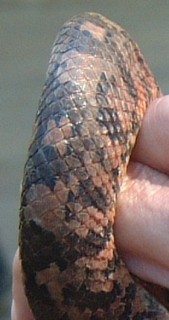 |
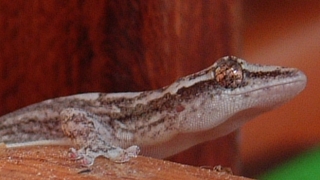 Both Tonga and Fiji are home to several species of gecko.
One of the Fijian geckos lives in the forest, grows to about 12 inches, and yaps
like a dog. (No, we’ve not heard it!) Aboard Ocelot we are home to one small
gecko (at left) that probably came aboard while we were hauled out in Tonga. We see it
occasionally around the galley but because geckos eat insects, we have let it be.
Both Tonga and Fiji are home to several species of gecko.
One of the Fijian geckos lives in the forest, grows to about 12 inches, and yaps
like a dog. (No, we’ve not heard it!) Aboard Ocelot we are home to one small
gecko (at left) that probably came aboard while we were hauled out in Tonga. We see it
occasionally around the galley but because geckos eat insects, we have let it be. |
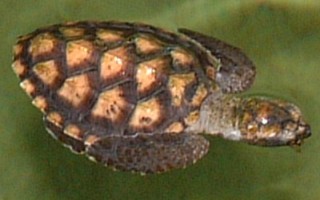 |
The Kula Eco Center acts as a breeding/raising ground for
endangered Hawksbill Turtles Eretmochelys imbricata. The photographed
animals are about 5” long, and about 3 months old. They will be kept in
the salt water tank on Viti Levu until they are large enough to be released into
the ocean. Swimming delicately with either front flippers or front and rear
flippers, these tiny turtles chase floating bugs or snap up food bits they are
given three times per day. Once hatched they spend their entire lives at sea,
and are able to float with their heads out of the water to breath while sleeping. |
| On the uninhabited beaches of Navadra Island Fiji and its small neighboring islands
we photographed these sea turtle tracks leading up from the water to
above the high tide mark where eggs were laid. It is apparently
not possible to tell whether it was a hawksbill, leatherback or green turtle that left
the track. All three turtles live and breed in Fiji, and while they are
protected under law, turtle meat and shells (especially of the hawksbill) are still sold in the market in Suva. |
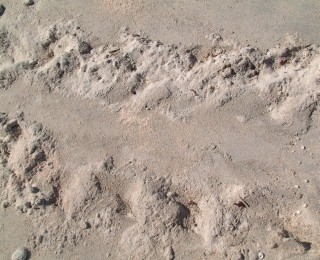 |
MAMMALS
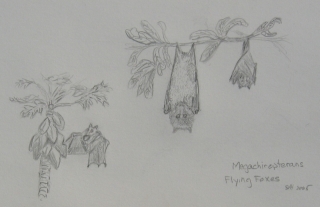 Because of the distance to other land masses, neither Tonga
nor Fiji host very many native land mammals. Both have several species of bats,
the most visible and impressive of which are the fruit bats
(family Pteropodidae, suborder Megachiroptera). These innocuous flying foxes (as they
are colloquially named) spend their days wrapped in their black pendulous wings,
hanging upside down from tree branches like shiny black and furry fruits. In
the early evening they launch themselves into the air, circling and flying high
above the land before coming down to feed on tropical fruits using their large
canines and sharp incisors to tear open the rinds. These large bats (with
wingspans up to 55" or 1.4m) do not have sonar. They emit squeaks and screeches,
and we often hear their high screeches as they battle for spaces in the branches of
their roosting tree. On our decks their droppings leave large
multicolored evidence of the variety of fruits they consume.
In Fiji, their major predator is the peregrine falcon. Several rehabilitated
animals are held at the Kula Eco Center on Viti Levu.
Because of the distance to other land masses, neither Tonga
nor Fiji host very many native land mammals. Both have several species of bats,
the most visible and impressive of which are the fruit bats
(family Pteropodidae, suborder Megachiroptera). These innocuous flying foxes (as they
are colloquially named) spend their days wrapped in their black pendulous wings,
hanging upside down from tree branches like shiny black and furry fruits. In
the early evening they launch themselves into the air, circling and flying high
above the land before coming down to feed on tropical fruits using their large
canines and sharp incisors to tear open the rinds. These large bats (with
wingspans up to 55" or 1.4m) do not have sonar. They emit squeaks and screeches,
and we often hear their high screeches as they battle for spaces in the branches of
their roosting tree. On our decks their droppings leave large
multicolored evidence of the variety of fruits they consume.
In Fiji, their major predator is the peregrine falcon. Several rehabilitated
animals are held at the Kula Eco Center on Viti Levu. |
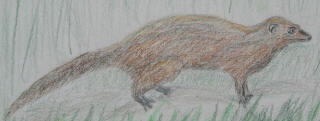 |
The most commonly seen mammal in Fiji is the Indian Mongoose.
These long, ferret-like animals dash across the roads and lurk in the cane
fields and plantation undergrowth in search of their favorite foods: small
reptiles, toads, and bird eggs. Imported to Fiji in 1883 to control rats in the
sugarcane fields, it has proliferated and become a pest, reducing the numbers of
some native land animals to near extinction. |
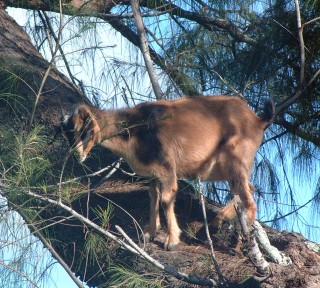
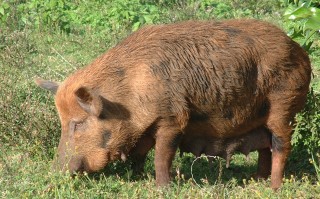 It wouldn’t be realistic to exclude the other large feral
mammals of Tonga and Fiji: pigs and goats. Both the pigs, brought by the
Polynesians, and the goats, introduced by the missionaries, were originally
domesticated animals that have now turned feral. It seemed like in Tonga there
were more pigs than people, especially on the small islands of the Ha’apai
Group. There are fewer pigs visible in Fiji, but the feral goats are fairly
numerous. We were never quite sure how the villagers know which animals belong
to whom, and which are feral! These animals are
responsible for massive destruction to native habitat and vegetation, and should
take some of the blame for decimation of the banded iguana population on Viti
Levu, along with the mongooses.
It wouldn’t be realistic to exclude the other large feral
mammals of Tonga and Fiji: pigs and goats. Both the pigs, brought by the
Polynesians, and the goats, introduced by the missionaries, were originally
domesticated animals that have now turned feral. It seemed like in Tonga there
were more pigs than people, especially on the small islands of the Ha’apai
Group. There are fewer pigs visible in Fiji, but the feral goats are fairly
numerous. We were never quite sure how the villagers know which animals belong
to whom, and which are feral! These animals are
responsible for massive destruction to native habitat and vegetation, and should
take some of the blame for decimation of the banded iguana population on Viti
Levu, along with the mongooses.
For more Fijian and Tongan animals go to South
Pacific Birds and Marine Mammals which
covers some of the marine mammals we have seen all across the Pacific Ocean.
Up | Tonga & Fiji Flora | Tonga & Fiji Fauna | Tonga & Fiji Birds
Tonga Home
| Tonga Newsletters
| Tonga Diving
| Tonga Cruising Info
| Fiji Home
| Fiji Newsletters
| Fiji Diving
| Fiji Cruising Info
West Indies Flora/Fauna | Venezuela Flora/Fauna | SW Caribbean Flora/Fauna | Galapagos Flora/Fauna | Fr. Polynesia Flora/Fauna | Tonga & Fiji Flora/Fauna | Australia Flora/Fauna | Southeast Asia Flora/Fauna | Sri Lanka Flora/Fauna | Madagascar Flora/Fauna | Marine Mammals
Top Level:
Home |
Destinations |
Cruising Info |
Underwater |
Boat Guests |
Ocelot |
Sue |
Jon |
Amanda |
Chris |
Site Map |
Make a Comment
 |
Lifetime
Commodores
of the
Seven Seas
Cruising
Association |
 |
|
If our information is useful,
you can help by making a donation
|
Copyright © 2000‑ Contact:
Jon and Sue Hacking -- HackingFamily.com, svOcelot.com.
All rights reserved.



 It wouldn’t be realistic to exclude the other large feral
mammals of Tonga and Fiji: pigs and goats. Both the pigs, brought by the
Polynesians, and the goats, introduced by the missionaries, were originally
domesticated animals that have now turned feral. It seemed like in Tonga there
were more pigs than people, especially on the small islands of the Ha’apai
Group. There are fewer pigs visible in Fiji, but the feral goats are fairly
numerous. We were never quite sure how the villagers know which animals belong
to whom, and which are feral! These animals are
responsible for massive destruction to native habitat and vegetation, and should
take some of the blame for decimation of the banded iguana population on Viti
Levu, along with the mongooses.
It wouldn’t be realistic to exclude the other large feral
mammals of Tonga and Fiji: pigs and goats. Both the pigs, brought by the
Polynesians, and the goats, introduced by the missionaries, were originally
domesticated animals that have now turned feral. It seemed like in Tonga there
were more pigs than people, especially on the small islands of the Ha’apai
Group. There are fewer pigs visible in Fiji, but the feral goats are fairly
numerous. We were never quite sure how the villagers know which animals belong
to whom, and which are feral! These animals are
responsible for massive destruction to native habitat and vegetation, and should
take some of the blame for decimation of the banded iguana population on Viti
Levu, along with the mongooses.